BSM explained: A guide to business spend management

Business spend management is more critical than ever.
Economic optimism is faltering. The Federal Reserve Bank of Richmond’s Q1 2025 CFO Survey shows a drop from a 10-year high of 71.2 to 62.1 in its optimism index. Now, finance leaders are under increasing pressure to optimize company spend and build cash reserves.
Navigating economic uncertainty involves striking a balance between business growth and short- and long-term spending. Amid the current landscape of political and economic instability, supply chain interruptions, and labor challenges, business spend management has become a strategic imperative. If your business doesn’t know where its money is going, it’ll quickly lose its way.

Strategic business spend management (BSM) is a continuous process that accounts for every penny your business spends. A solid spend management strategy — built on a foundation of accurate, real-time spend data collection and analysis — gives you complete visibility and control over the following:
- How much money your company spends
- What it spends it on
- Who is approving the expenditures
In this guide, we’ll help you develop a BSM strategy that provides the clarity and understanding you need to steer your business toward stability and growth. You’ll learn how to:
- Understand the importance of business spend management
- Design an effective spend management strategy
- Evaluate spend management tools and automation solutions
- Start a spend management program
You’ll be able to manage spending, optimize vendor relationships, and anticipate and mitigate expense risks before they hit your business.
Let’s get started.
What is strategic business spend management really about?
Gartner defines strategic business spend management as “a set of practices that ensure organizations make procurement and sourcing decisions in the interests of both the bottom line and company efficiency.”
It pinpoints where a company is losing money, where spend processes and policies can be optimized, and where risks can be reduced. To do this, BSM combines processes, technologies, and tactics to optimize core spending processes, such as:
- Supply chain management
- Contract lifecycle management
- Spend analytics and forecasting
- Strategic sourcing
- Procure-to-pay (P2P) management
Business spend management vs expense management
Although they’re similar, spend management isn’t the same as expense management. Expense management is the system that processes and pays employee expenses, like travel. BSM controls all spending, including employee expenses. So, an effective and efficient expense management process is a core component of the overall business spend management strategy.
Why is business spend management important?
Managing spend isn’t easy, but the costs of not managing spend are high. Poor spend management can lead to low visibility, noncompliance with expense policies, higher transaction costs, and operational inefficiency as finance teams track down and verify expenses. This can harm your business and affect your customers, suppliers, employees, and shareholders.
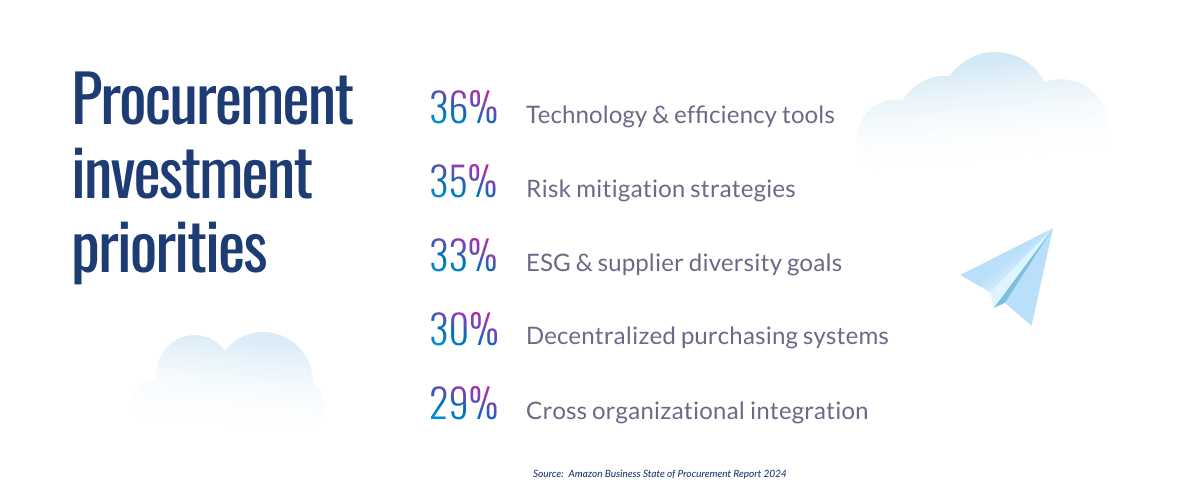
Benefits of spend management
Business spend management enables you to track, analyze, and manage business expenditures in every aspect of your organization. It provides timely, accurate data that helps you make informed, data-driven spending decisions. Here are some ways BSM can help you achieve your spend management goals.
Reduce spending errors and fraud
Unclear policies, inefficient paper-based manual expense procedures, and inadequate spend data tracking can allow errors and fraud to slip through the cracks, putting your business at risk of financial loss.
BSM helps you track spend data and approve expenses in real-time, letting you quickly detect and mitigate errors and fraud. For example, a P2P system could notify a purchasing manager that the price of laser printer toner has increased in the past quarter. The manager can investigate and address the price increase and reduce costs with this information.
Centralize spending data
According to the Amazon Business State of Procurement Report 2024, 30% of procurement teams said decentralizing purchasing was a top priority. When asked about short-term goals, 81% also said establishing or refining cross-company procurement standards was a major goal for the next two years.
By capturing all expenditure data in real time, BSM ensures you won’t be kept in the dark when purchasing is decentralized. It reveals areas where your business isn’t spending effectively and helps you ensure that procurement standards are being met.
Improve labor productivity
Automating manual processes frees employees from tedious, repetitive tasks. This allows them to focus on higher-value work, such as identifying cost savings. For example, after implementing Stampli, Superior Masonry saved 40-60 hours/week — time employees now spend refining the company’s job costing and improving profitability.
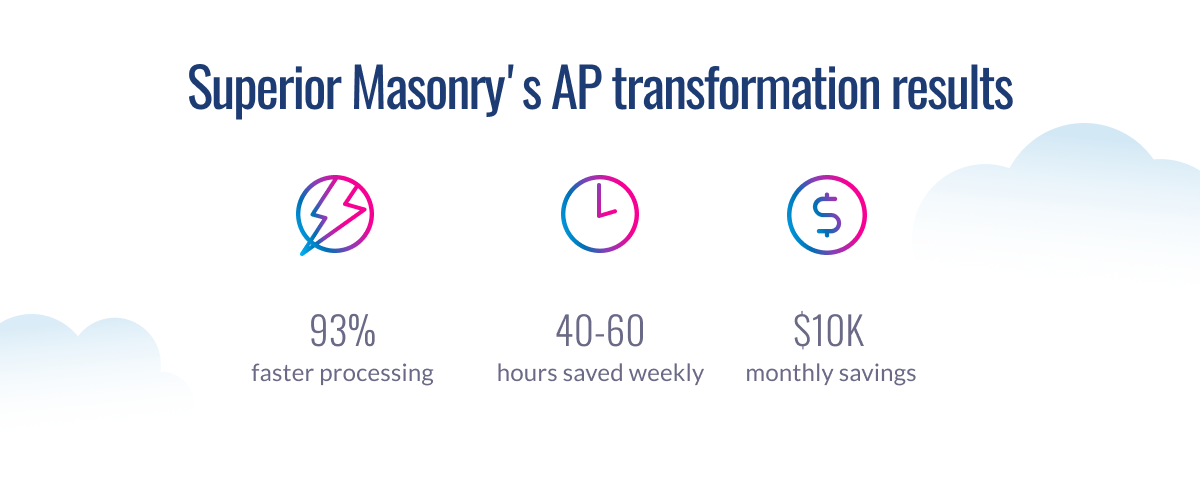
Support business growth
For most businesses, growth often requires significant spending that — if it isn’t managed correctly — can lead to missed opportunities and cash shortfalls.
BSM makes it easier to manage the high volume and speed of increased spending to support growth. With real-time visibility into your expenditures, you always know how much money you have on hand to invest in new opportunities. You can detect and address minor problems quickly before they have the chance to grow into big ones.
Having accurate and up-to-date financial and performance data also doesn’t hurt when your business wants to attract investors.
Reduce borrowing costs
As your cash flow management becomes more efficient, your business will need to borrow less to finance operations and growth. This results in reduced interest costs.
Optimize vendor negotiations
BSM gives you access to current spending data and contract terms for each supplier, offering the flexibility to negotiate better pricing and terms. Detailed spending data also simplifies the process of switching suppliers when needed, as you won’t have to waste time digging for the right information.
How to build a business spend management strategy
To manage cash flow for growth, you need to develop a long-term spend management strategy that defines smart spending goals and outlines the steps to achieve them. You should align the strategy with your overall business objectives and ground it in solid data.
Core elements of a successful spend management process
Your BSM strategy should include plans for simplifying expense processes and procedures, integrating business spend management tools with other business processes and tools, as well as collecting, analyzing, and reconciling spend data.
Build the strategy around these four pillars:
- Build a spend management team
- Evaluate and analyze spending
- Create spending forecasts
- Build a spend management plan
Let’s take a closer look at each step.
1. Build a spend management team
Construct a team to manage your BSM strategy. Include stakeholders who influence business spending — such as procurement, AP, sourcing, IT, and finance. The team’s first task is to establish spend management goals and develop a plan to achieve them.
2. Evaluate current spending
Data is at the core of any successful spend management strategy. Begin your strategic planning process by collecting and analyzing information on your current expenditures. Gather spending information, including purchase requisitions (PRs), purchase orders (POs), goods receipts, invoices, and transaction data. Also gather information on supplier contracts, expense policies, spending categories, and existing spend management tools.
Once you’ve gathered the data, store it in a central location. Then, begin analyzing the data. A good starting point is to sort the data into spending categories such as office supplies, rent, or utilities. You can also sort the data by other criteria, like location, supplier, or business unit. Sorting the data this way provides valuable insights into expenditures related to different factors.
Analysis will also help you identify discrepancies and opportunities for cost savings or process improvements. Study the data to identify spending patterns or process bottlenecks. For example, if you notice a high number of erroneous payments, it may indicate a flaw in your invoice-matching process.
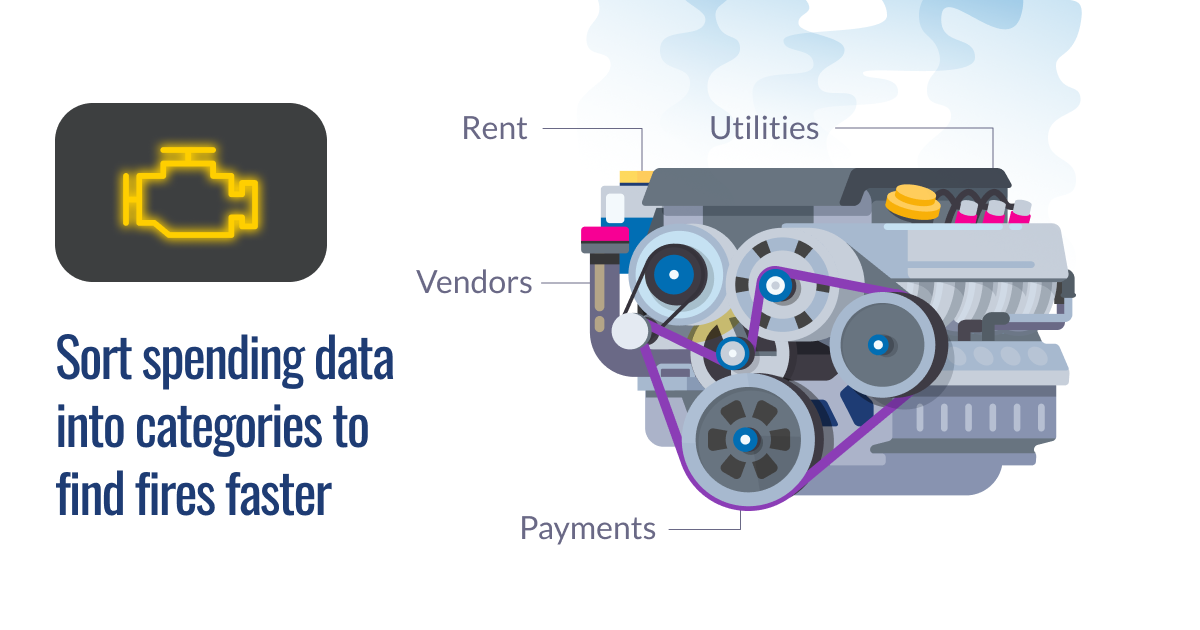
3. Create spending forecasts
Use the insights from your analysis to identify cost-saving opportunities and design BSM initiatives to achieve them. Data forecasting enables you to estimate the impact of these initiatives and helps you proactively anticipate changes. This allows you to plan future expenditures and optimize supplier relationships.
4. Build a spend management strategy
After you’ve set up your team, collected and analyzed spending data, and forecasted your spending goals, it’s time to put things into action. You’ve got a couple of options at this step:
Put out the fires
Immediately address any discrepancies that are causing your company to lose money. For example, if you detect signs of fraud, you should perform an internal audit to determine the cause and identify the perpetrators.
Unify expense and procurement policies
If your analysis reveals that your organization has multiple expense and procurement policies, consider ways to unify these into a single policy or establish blanket terms to be included in multiple policies. For example, you could set a company-wide policy requiring director approval on all purchases over $100,000.
Streamline and optimize procure-to-pay workflows
During your analysis, you likely discovered several areas for improvement in your P2P and finance workflows. Optimize these workflows by reducing manual touchpoints, enhancing internal controls, and leveraging automation. Let’s look at a few examples of how you can achieve this.
BSM example: Streamlining P2P and AP processes
Overloaded P2P and invoice management processes can negatively impact cash flow, resulting in a ripple effect on your financial health. Here are some steps you can follow to optimize these processes and gain more control over spending.
1. Track current processes
Learn what happens when your company creates a PR or PO and when it receives a supplier invoice. Track every step from request to payment, asking:
- How are you creating PRs and POs? Are the forms standardized?
- Who is approving purchase requisitions?
- How is invoice data being captured and entered?
- Who checks invoices for errors? What if they find an error? Who is responsible for resolving the error?
- How are invoices approved? Who is responsible for approvals?
- How are approved invoices paid? Who owns the payment process?
2. Look for areas of risk
After tracking your processes, identify and flag areas where there’s a risk of maverick spending, errors, delays, or fraud. Check critical touchpoints such as:
- Do PRs, POs, and invoices contain the correct information and PO number?
- Are you using two- or three-way matching to detect discrepancies between POs, invoices, and shipping receipts?
- Are you enforcing separation of responsibility for high-risk tasks?
- How are discrepancies and disputes resolved with suppliers?
- Are you paying late fees? How much are they costing?
- Are supplier discounts reflected on POs and invoices?
- Is the tax information on invoices correct?
3. Optimize processes
Once you have a clear understanding of your processes and areas for improvement, you can make informed decisions about selecting the most effective optimization solutions. For example, say you learn that your company frequently makes large purchases without approvals. You can implement purchasing software that automates approval routing, ensuring every PO is reviewed and approved.
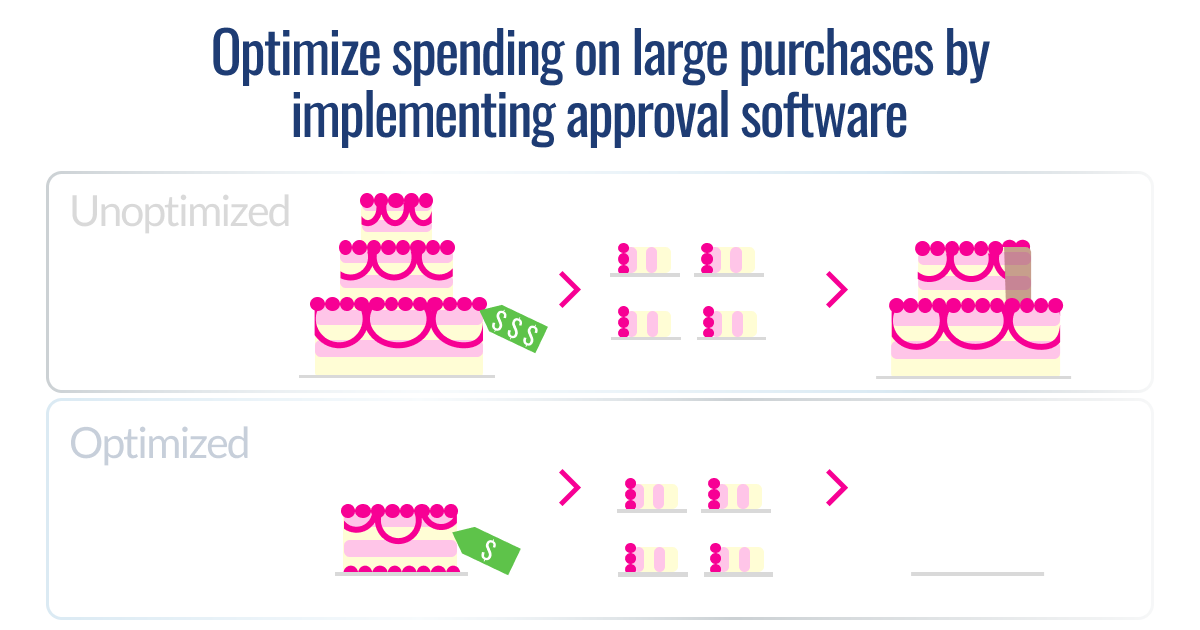
BSM example: Improving supplier relationships
Managing a positive supplier relationship costs less in time and money than repairing the damage from a dysfunctional one. Improving supplier relationships by facilitating clear communications, efficient purchasing and AP processes, and prompt payment can pay dividends, including:
- Healthier cash flow through favorable vendor credit and payment terms
- Early payment and volume discounts
- Reduced errors, fraud, and disputes
- Supplier continuity, saving the cost of switching to a new supplier
Here’s how you can strengthen vendor relationships through BSM in four steps.
1. Identify your outsourcing needs
Review where your business currently outsources and identify areas where outsourcing could bring cost savings. Consider expanding existing supplier relationships, such as in product development, P2P process optimization, or supply chain management. For example, integrating a trusted supplier more closely into your P2P process by transitioning to an e-procurement platform can reduce purchasing turnaround times and improve order accuracy.
2. Choose criteria for selecting suppliers
Choose the criteria to use for assessing potential suppliers. Consider factors like price, adherence to quality standards, reputation, and capacity. Sourcing strategically lets you optimize spend and mitigate risk by ensuring you select the right vendors.
3. Develop a supplier management structure
Set clear guidelines for managing your supplier relationships to keep everything organized and under control. Elements of an effective framework include:
- Onboarding process and documentation requirements
- Frequency of status meetings and performance reviews
- Clear dispute resolution process
- Quality and delivery time service level agreements (SLAs)
- PO and order fulfillment process
- Supplier termination process
4. Track and manage supplier performance
Establish how you’ll measure and manage supplier performance. Set KPIs such as order-to-delivery times, quality assurance, and shipment accuracy. Set up recurring status meetings with each supplier to track these deliverables and resolve any issues.
These examples show how a focused BSM approach can help you optimize spending and manage cash flow effectively. Streamlining P2P processes traditionally involved optimizing manual or partially digitized workflows, which was time-consuming and could create more problems than it solved. Today, however, businesses are increasingly adopting financial automation software for more efficient, cost-effective, and scalable BSM solutions.
The compelling case for business spend management automation
In the past, businesses typically managed their spending using manual tools, such as spreadsheets. These methods were inefficient and prone to errors if not performed correctly.
Today, many businesses are looking to financial automation software solutions to automate their spend management processes. Automation allows for a cost-effective, centralized, sustainable, and scalable BSM solution that provides real-time spend data analytics and control over expenditures. Here are some benefits of BSM automation:
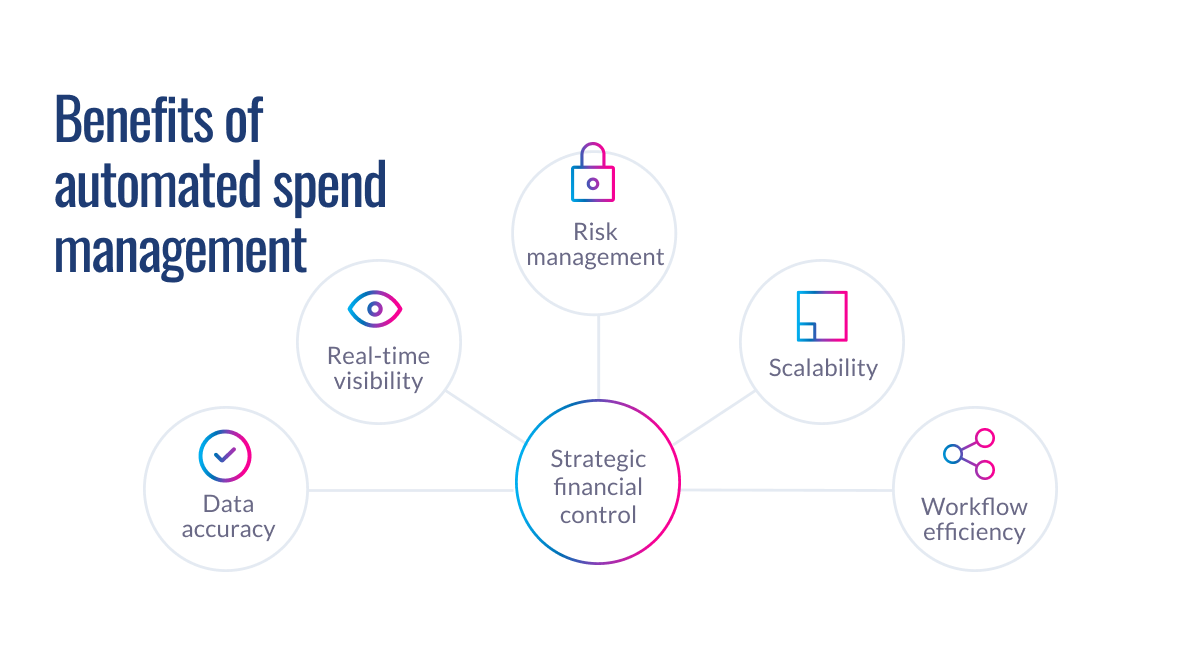
Real-time visibility into business expenses
Most spend management solutions automatically collect, track, and report expenditure data and perform category management. They automatically categorize actual spending by department, category, or supplier and compare it to your budget, allowing you to control costs in real-time.
More efficient expense workflows
Automation solutions streamline or eliminate inefficient manual processes, helping you save time and money. By centralizing spend data, they also make it easier for teams to communicate with each other and with vendors and stakeholders, helping reduce errors and delays.
Accurate spend data
Spend management software collects and consolidates spend data to provide a single source of truth on expenditures. This capability provides a solid data foundation for spend analysis, financial reporting, budgeting, and planning.
Better risk management and financial controls
BSM software lets you quickly and easily implement company-wide spending processes and policies. It tracks and records every transaction and user action to help you maintain a complete audit trail and enforce compliance with internal controls and expense policies. It also automatically checks spend data for errors and traces of fraud, allowing you to reduce the risk of financial losses.
Accounts payable (AP) and P2P platforms feature automated purchase and payment approval workflows to ensure purchases are approved before they happen. Some platforms also track vendor performance, allowing you to detect and address supplier risks before they become serious.
Flexibility and scalability
Cloud-based spend management solutions allow you to manage expenses across geographically dispersed teams and remote workers. Employees and stakeholders can access the spend management system online from any location. Cloud-based solutions can also scale as needed to keep pace with your company’s growth.
With these core elements in mind, let’s look at how to select and implement the right BSM solutions for your business.
How to choose a business spend management platform
The tools you use to automate your BSM strategy can make the difference between success and failure. An effective strategy requires accurate real-time data on almost every aspect of your business expenditures.
You can use software tools to automate processes and track and manage business spending. The right all-in-one solution — or combination of point solutions — can help you prevent overspending, optimize processes, and forecast the impact of your BSM initiatives.
The ideal solution is the one that fits your size, culture, and industry, and is flexible and scalable enough to support future growth. Look for solutions designed for similar businesses in your industry. For example, check out Stampli’s case studies to see how automating accounts payable has helped other businesses reduce costs.
Let’s look at the factors that go into finding the best fit for your business.
What BSM functionality do you need?
Choosing the right business spend management solution can be challenging. The right tool needs to be flexible and powerful enough to meet your business needs as well as cost-effective and easy to implement and use.
Look to your spend management strategy to see where automating spend processes and functions makes sense. For example, if you manage a large volume of paper requisitions and invoices, consider solutions that incorporate optical character recognition (OCR) for automatic scanning and data entry.
Let’s see how BSM automation can help optimize specific spending functions and processes.
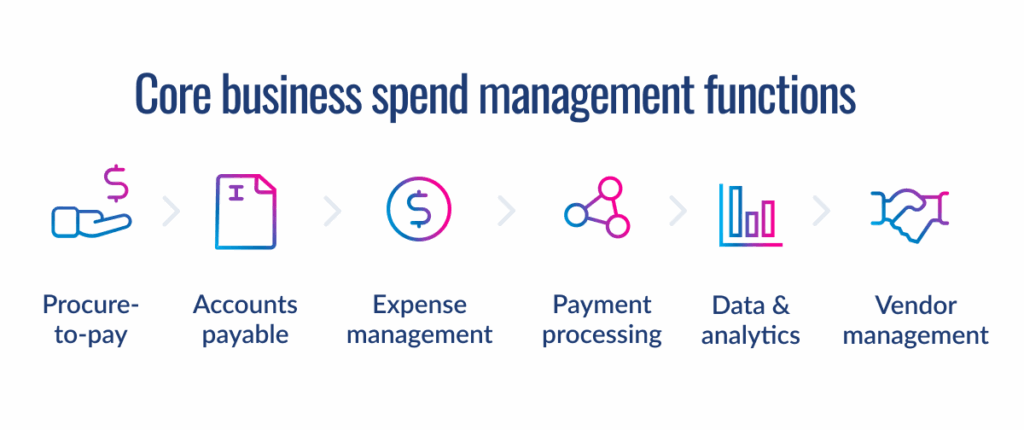
Procure-to-pay
End-to-end P2P solutions, such as Stampli, automate the entire procurement lifecycle — from the initial purchase request to final payment. They reduce costly errors and delays by streamlining procurement processes and eliminating manual tasks. One major benefit of using a P2P system is that it automates request and approval workflows, ensuring that every request and purchase is reviewed before an order is placed. It also keeps a central record of purchase requisitions, POs, goods received receipts, vendor contracts, and invoices — making it easy to track and verify purchases.
Accounts payable
AP automation solutions streamline invoice capture, entry, verification, and approval processes. Leading solutions use AI and machine learning to completely automate complex tasks like extracting and general ledger (GL) coding invoice data with a high degree of accuracy. This ensures every transaction is captured and categorized. AP automation platforms also automate invoice and payment approvals, ensuring that invoices are reviewed before payment is made.
Some AP solutions provide automated three-way matching of POs, invoices, and goods received notes to verify that invoices are correct. For example, Stampli’s Cognitive AI™ PO Matching solution understands context and can accurately and efficiently validate invoices 99% of the time, further reducing the risk of erroneous payments.
Expense management
Expense management platforms optimize your employee expenditure processes to make it easier for employees to make purchases, keep employee spending under control, and shorten expense approval processes. You can use expense software platforms to reduce unauthorized spending by creating and enforcing company-wide expense policies.
Expense management tools automate approval workflows and expense claim processes. Employees can automatically submit approval requests, expense reports, and receipts through an online dashboard or mobile app. Approvers can review and approve expenses in real-time.
Many expense management platforms include virtual credit cards to allow employees to purchase goods and services. Card solutions like Stampli Cards provide several benefits for controlling costs:
- You can restrict the card to one employee, supplier, or project to eliminate overspend
- Users can assign the card to a specific spend category to track expenses by project, department, or supplier
- You can set a preset spend limit and track employee spending in real-time
Vendor management
One of the most effective ways to manage business spending is through proactive vendor management. BSM software packages provide vendor management functionality, including contract lifecycle management, to track contract terms and renewal dates. Others offer online vendor portals that let vendors ask questions, send invoices, and keep their information and documents up to date. This makes it easier to stay on top of transactions and prevent expensive disputes and errors.
Payment processing
Payment processing applications automate manual payment workflows and unify payment methods onto a single platform. By integrating with AP and P2P systems, they help minimize errors and prevent fraud through automatic transaction data synchronization. They also let you choose lower-cost payment methods, such as ACH transfers, to save on transaction fees.
Data analytics
Most BSM platforms provide built-in analytics and reporting functionality. They provide you with accurate, real-time insights into process performance, spending patterns, and payments. You can access or calculate spending KPIs such as days payable outstanding, cash flow, invoice lifecycle, first-time match rates, and invoice error rates to help pinpoint bottlenecks and areas for improvement.
Point or all-in-one solution?
Consider whether to opt for a point solution that automates a specific process or function, or a comprehensive, all-in-one solution that automates every aspect of spend management.
All-in-one solutions combine expense management tools, process automation, and analytics into a single centralized solution. They aim to simplify and unify spend management workflows across your organization using a single transparent platform. While there probably isn’t a spend management tool that does everything for everybody, all-in-one tools offer businesses a high level of flexibility, scalability, and the capability to manage expenditures effectively.
Point solutions automate a specific function or business process, such as procurement, supply chain management, or invoice processing. They typically provide a highly specialized and powerful level of automation for businesses that need a sophisticated approach. While they don’t promise full end-to-end automation, point solutions typically integrate with ERPs, CRMs, and other business systems to support comprehensive automation.
Integration with existing systems and processes
Whether you choose an all-in-one or point solution, you’ll need to integrate it and share data with other business systems, such as your ERP or CRM. Integration provides a single source of truth for spend data across the organization. Look for platforms with a reputation for seamless, trouble-free integrations.

End business spend obscurement with Stampli
The real BSM challenge is obscurement.
If you can’t see what’s really driving your spending, and you don’t have a big-picture view of procurement and spending processes, you have an obscurement problem.
Obscurement is caused by a lack of connections within procurement and business processes. It creates gaps and blind spots that keep you from tracking and controlling what your business spends. If you want to solve the chaotic workflows, approval delays, and budget back-and-forth that obscurement brings, then you need to connect every dot.
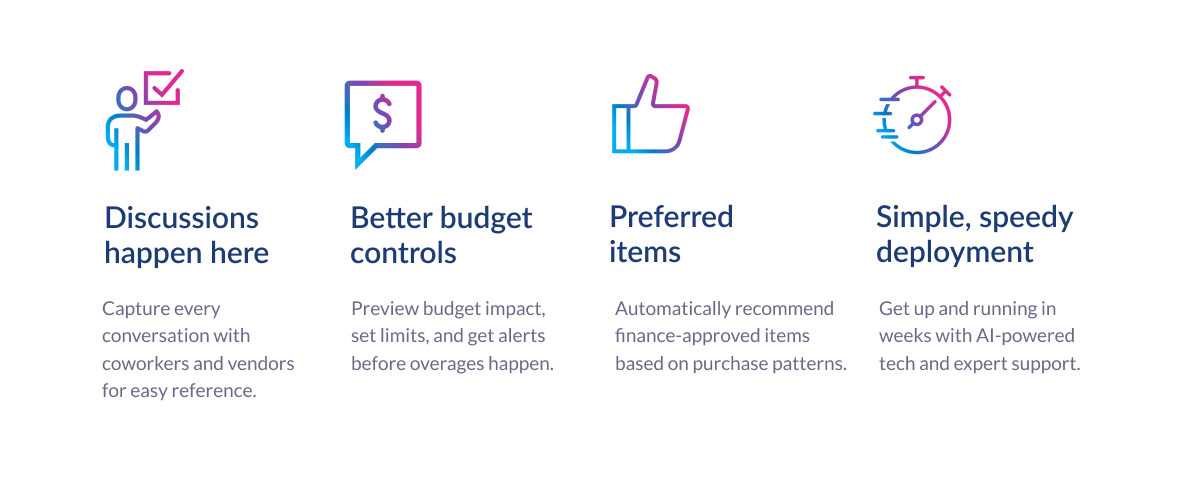
Stampli brings clarity by helping you connect the dots in your BSM strategy. It gives you visibility and control over the following.
Every request
Monitor and manage purchases, travel, office supplies, IT, services, or anything else your business needs through Stampli.
Every process
Get support for any combination of fulfillment and approval workflows. Route any request through the right person or team at the right time in the process.
Every record
Stampli tracks every discussion, decision, and document, giving you full spend visibility and a complete audit trail.
Contact one of our experts today to see how Stampli connects every dot of your business spending management strategy.